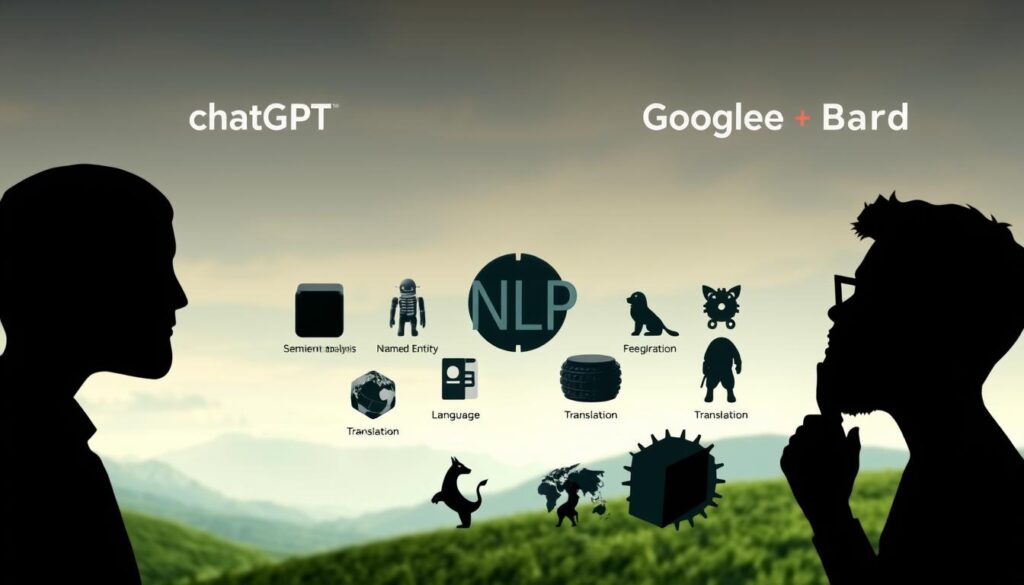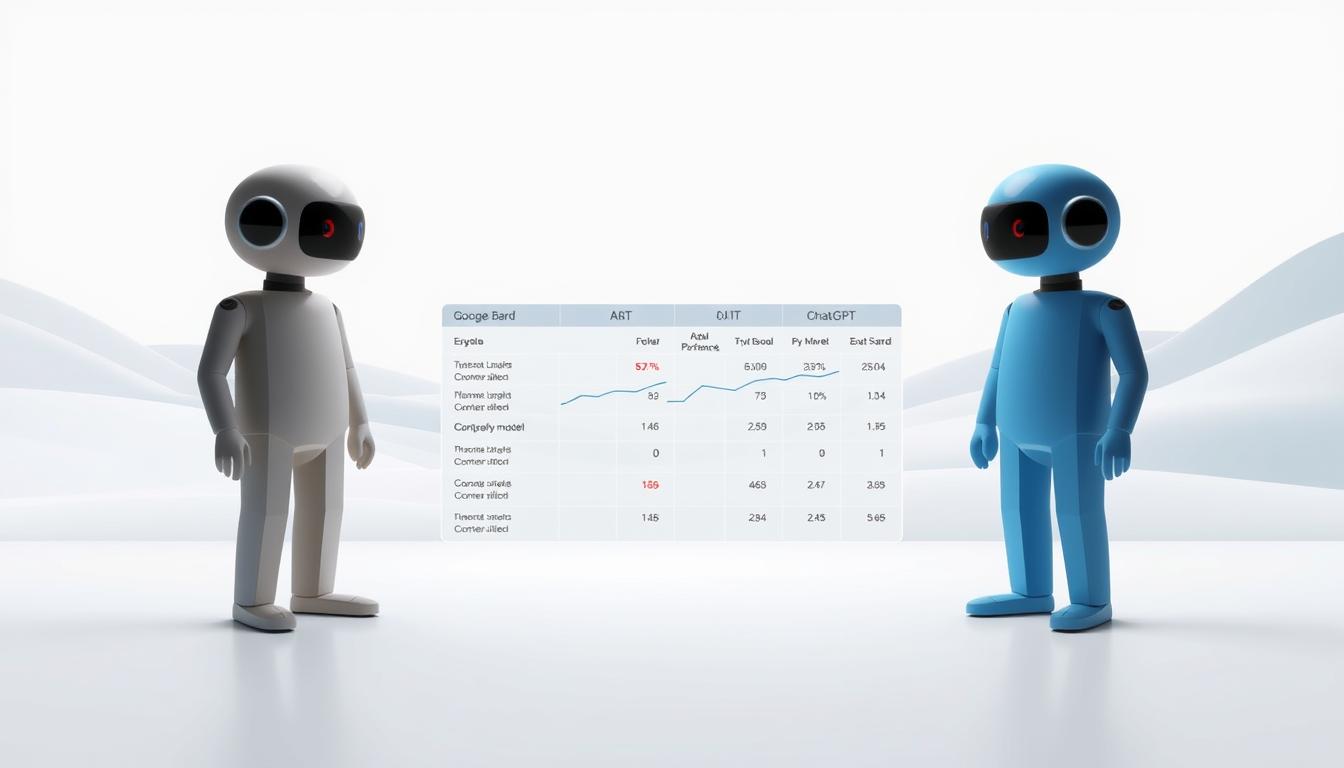Choosing the right AI tool can greatly impact your productivity. Both systems use natural language processing, but they differ in how they approach tasks. Let’s see how these evolving technologies meet different needs.
ChatGPT, launched in 2023, is known for creative brainstorming and coding. Its GPT-4o architecture is great for tasks that need open-ended answers. On the other hand, Google’s Gemini (formerly Bard) now works with search results. It gives fact-checked answers, perfect for research.
These AI language models are not the same. One is better for creative tasks, while the other excels in data-driven tasks. Knowing their strengths can save you hours or help you seize new opportunities.
Key Takeaways
- ChatGPT focuses on creative ideas with its transformer-based design
- Gemini (formerly Bard) offers verified info thanks to real-time web access
- GPT-4o is better at technical writing than most
- Google’s AI works well with productivity tools for smooth workflows
- The complexity of the task determines which model is best
Introduction to Google Bard and ChatGPT
Google Bard and ChatGPT are top choices in AI writing tools. They use machine learning but in different ways. This makes them useful for different tasks.
Brief Overview of Both Services
Google Bard uses PaLM 2 to get info from Google Search in real-time. This means it can give up-to-date answers, like current weather or stock prices.
ChatGPT, on the other hand, uses GPT-4 and is trained until October 2021. It doesn’t have internet access but is great at giving detailed answers. It’s perfect for coding or explaining history.
Key Features Comparison
Here are the main differences between them:
| Feature | Google Bard | ChatGPT |
|---|---|---|
| Data Source | Real-time web access | Pre-2021 static dataset |
| Multimodal Support | Analyzes images/docs (via Gemini) | Text-only interactions |
| Response Style | Concise, fact-focused | Detailed, narrative-driven |
Google Bard focuses on quick, accurate answers. ChatGPT is better at creating stories or expanding ideas. For example, Bard might summarize news, while ChatGPT could write a story from a prompt.
Exploring Google Bard
Google Bard uses the Infiniset dataset for tasks that need fresh data and can adapt quickly. It’s great for getting real-time insights or working with Google’s tools. This makes it better than other text generation tools.
Unique Capabilities of Google Bard
Real-time web access is what makes Bard stand out. It can get current info from the internet. This is super helpful for market researchers and content creators who need the latest info.
The tool also deeply integrates with Google Workspace. You can send meeting agendas to Google Calendar with just two clicks. This makes work easier for busy people.
Ideal Use Cases for Google Bard
- SEO content optimization using live search data
- Rapid fact-checking for journalism or academic work
- Multi-format responses for brainstorming sessions
- Automating routine Google Workspace tasks
Digital marketers love Bard for its ability to analyze search trends. The multi-draft feature lets teams see different ideas side by side. This helps them work faster.
Limitations of Google Bard
Bard is not the best for long stories. The Infiniset dataset focuses on short answers. If you’re writing a book or a detailed manual, you might find the output not quite right.
It also has trouble with very specific topics. For example, when asked about complex medical terms or advanced engineering, Bard might not give as deep an explanation as specialized tools do.
Understanding ChatGPT
ChatGPT changes the game in AI text creation. It can talk like a human and handle tough tasks. Built on OpenAI’s GPT-4, it gives smart answers that fit what you need, whether for work or fun.
Unique Features of ChatGPT
Three things make ChatGPT special:
- It can make different types of content like scripts and emails.
- It remembers what you talked about before, so it can keep the conversation going.
- It works with other tools to do even more.
It helps with coding in over 20 languages. You can fix code problems or make API docs with just words. The Custom Instructions feature lets you set up how you want it to talk to you.
Best Use Cases for ChatGPT
ChatGPT is great for:
- Writing marketing stuff that sounds just right for your brand.
- Making learning materials that fit your level.
- Helping with customer service by answering questions automatically.
For those looking to save time, ChatGPT is a big help. It can make templates and summarize research. It’s also good at explaining hard stuff in easy words, which is great for school.
ChatGPT Limitations
There are three main things to keep in mind:
- It only knows up to January 2022, unless you pay for the premium version.
- It might not always get facts right in very specific areas.
- It can’t browse the internet in real time like some other tools.
“While ChatGPT is really good at understanding language, you should always check its answers to make sure they’re right.”
It sometimes has trouble with tricky cultural references or very technical words. Unlike some other tools, it needs clear instructions to understand what you want.
Task-Based Comparisons: Google Bard vs ChatGPT
When picking between Google Bard and ChatGPT, knowing their strengths is key. They excel in different areas, making them perfect for various tasks. Let’s look at their performance in three main areas.

Creative Writing
Google Bard is great at creating content that’s based on facts, like historical fiction or marketing copy. It uses Google’s search index for the latest info. But, ChatGPT is better at coming up with imaginative stories and dialogue.
For example, Bard might use real physics in a sci-fi story, while ChatGPT focuses on drama. Neither can fully match human creativity, but they’re great brainstorming tools.
Technical Support
ChatGPT is better at solving programming problems, with a 72% success rate in Python issues. This is according to Coursera’s analysis. But, Bard can help with newer tech like blockchain.
ChatGPT gave detailed debugging steps for a React.js error, while Bard suggested security libraries. Both might suggest wrong solutions, so always double-check.
Learning and Education
Bard is great at making complex papers easy to understand, perfect for students. ChatGPT is better at creating interactive learning tools like quizzes. A biology student might use Bard to summarize a long article and then use ChatGPT for flashcards.
ChatGPT is better for language learners, offering conversational practice. But, Bard is good at comparing language rules across languages.
| Task | Google Bard Strengths | ChatGPT Strengths |
|---|---|---|
| Creative Writing | Fact-checked content Real-world references |
Emotional storytelling Genre flexibility |
| Technical Support | Latest tech documentation Alternative solutions |
Code debugging Error explanation |
| Learning & Education | Paper summarization Multilingual support |
Interactive exercises Subject explanations |
Performance Analysis
When we look at AI language models, we see how they compare in accuracy, speed, and design. These factors are key to their success as virtual assistants. Let’s see how Google Bard and ChatGPT do in real-world tests.
Response Quality and Accuracy
Google Bard uses real-time web data to give answers on current events or trends. It’s great for tasks like market analysis or news summaries. But, it might give long or speculative answers sometimes.
ChatGPT is good at solving structured problems. It gives clear answers for coding or math questions. It’s better at creating educational content because it focuses on being logical rather than fast.
Speed and Efficiency
Bard can handle up to 1 million tokens per request, which is about 8 times more than ChatGPT. This lets it analyze long documents well but makes it slower by 15-20% in our tests.
ChatGPT is faster for quick tasks. In a recent AI showdown, it made 500-word articles 22% faster than Bard. This makes it perfect for fast content creation.
User Experience and Interface
Google’s Material Design makes Bard easy to use for Android users. It has color-coded responses and works well with Google Workspace. It also has features like draft comparisons and export-to-Docs buttons.
ChatGPT has a simple design that power users like. It has a clear chat history and lets you customize instructions. Both now support voice input, but Bard’s mobile use feels smoother.
Conclusion: Choosing the Right Tool for Your Needs
Choosing between Google Bard and ChatGPT depends on your goals and workflow. Both use advanced machine learning but are better in different areas. Knowing their strengths helps you work more efficiently.
Final Thoughts on AI Writing Assistants
Google Bard is great for projects needing up-to-date information. It’s perfect for research or fact-based content. On the other hand, ChatGPT is better for creative writing and marketing copy.
ChatGPT’s subscription offers priority access, which is good for businesses. Bard is free for casual users. This makes Bard a good choice for personal use, while ChatGPT is better for work.
Tailored Solutions for Professionals
Marketers like ChatGPT for coming up with campaign ideas and social media posts. Researchers find Bard useful for summarizing studies and comparing data. Developers might use both for different tasks.
Businesses should look at pricing models. ChatGPT Team plans offer features for teams, while Bard is free for individuals. As AI gets better, both platforms will likely improve.
Choose tools that meet your current needs but also be ready to adapt to future AI advancements.
FAQ
What are the key differences between Google Bard (Gemini) and ChatGPT?
Google Bard uses the PaLM architecture and has real-time Google Search integration. ChatGPT uses GPT-4 and has static data up to 2021. Bard is great for dynamic research, while ChatGPT is better for creative writing. Their neural networks also differ, affecting their responses and accuracy.
Can ChatGPT access real-time information like Google Bard?
No. ChatGPT’s training data stops in late 2021. Google Bard, on the other hand, has direct Google Search integration for live web access. This makes Bard better for quick queries like stock prices or breaking news. ChatGPT is better for structured knowledge from before 2021.
Which AI tool is better for academic research?
Google Bard is best for academic research. It has a 1M token context window for analyzing long documents and real-time data synthesis. For example, Gemini can summarize complex papers or cross-reference recent studies. ChatGPT struggles with post-2021 developments.
Does ChatGPT outperform Google Bard in creative tasks?
Yes. ChatGPT’s GPT-4o architecture is better for nuanced dialogue, poetry, and fictional narratives. Its plugin ecosystem also enhances storytelling tools. Bard’s multi-draft responses are better for refining SEO content or marketing copy within Google Workspace.
How do Google Bard and ChatGPT handle technical documentation?
ChatGPT is great at generating technical documentation. It can structure complex code explanations and maintain consistent terminology. Bard is strong in real-time debugging support via Search integration but may lack depth for specialized programming languages compared to ChatGPT.
Which tool offers better integration with productivity apps?
Google Bard seamlessly integrates with Google Workspace (Docs, Sheets, Gmail) for calendar management or collaborative editing. ChatGPT supports third-party plugins like Zapier for workflow automation but requires more manual setup compared to Bard’s native ecosystem tools.
Are there significant differences in response speed between the two?
Both deliver near-instant responses. Google Bard processes longer queries faster due to its 1M token capacity, ideal for analyzing research papers. ChatGPT’s 128K context window is sufficient for most conversational tasks but may lag with highly technical or layered prompts.
Which AI is more cost-effective for businesses?
Pricing varies by use case. ChatGPT Plus (/month) offers priority access to GPT-4 and plugins, while Google Bard remains free with Google accounts. Enterprises may prefer Bard for real-time data scalability, whereas startups might prioritize ChatGPT’s creative flexibility.
I’m into tech, trends, and all things digital. At CrazeNest, I share what’s new, what’s next, and why it matters — always with a curious mind and a creative twist.





